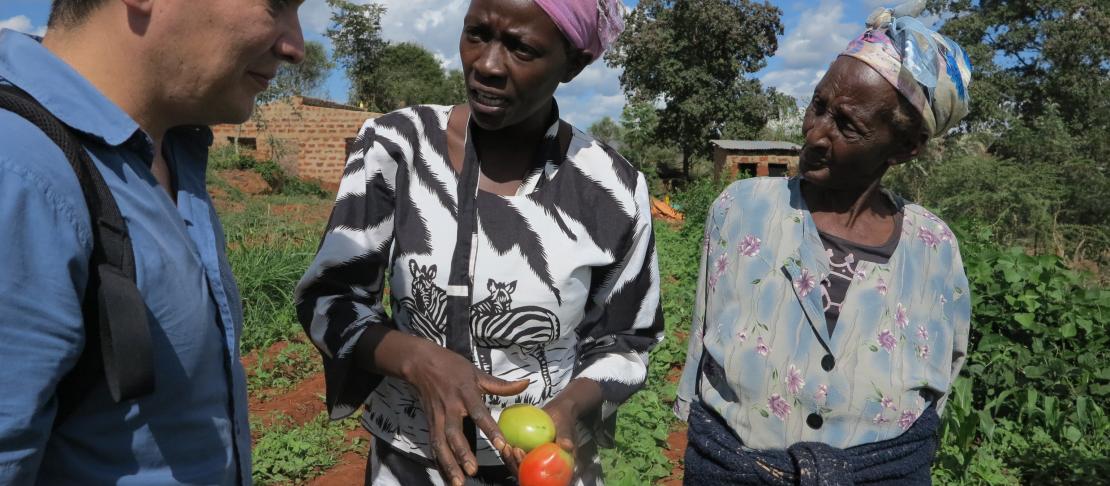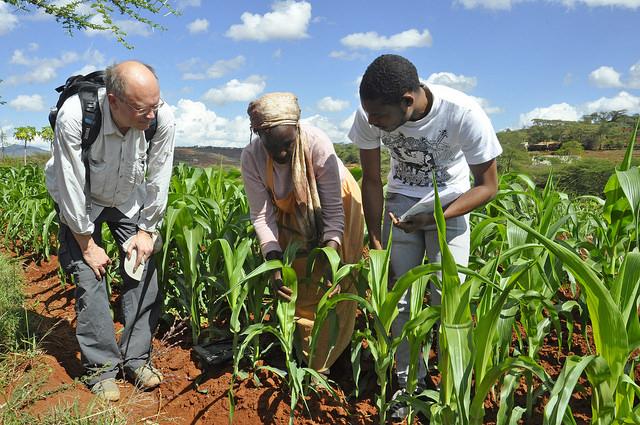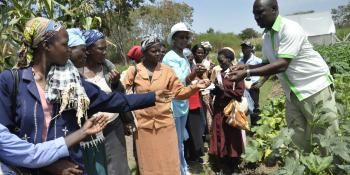Learning from adaptation experiences of local communities in Makueni, Kenya

Delegates to the 9th conference on community-based adaptation visited Makueni, Eastern Kenya and interacted with local communities thereby learning about various initiatives being implemented to address climate change and food insecurity.
“We have heard the challenges these farmers face first hand due to climate change impacts. The various adaptation initiatives being demonstrated here are quite encouraging since farmers are now able to feed their families as well as earn income to address other household needs. However, the big question is: how can we upscale such initiatives?” asked Jean-Pascal Van Ypersele, Vice-Chair of the Intergovernmental Panel on Climate Change (IPCC).
Jean-Pascal was speaking during a field visit to Makueni, a CGIAR Research Program on Climate Change, Agriculture and Food Security (CCAFS) East Africa learning site organized for delegates who would later attend the 9th International Conference on Community-Based Adaptation to Climate Change (CBA9) held from 27 to 30 April in Nairobi. The visit provided an opportunity for shared learning based on ongoing work in the field for delegates from 21 countries.

jean-pascal (left), vice chair - IPCC INTERACTS WITH A FARMER DURING THE FIELD VISIT. photo: p. kimeli (CCAFS)
Climate change and variability in Machakos and Makueni, Eastern Kenya, has led to increased frequency of severe droughts in the last 50 years. Incidences of failed seasons are reported in two out of every five seasons. Consequently, malnutrition and poverty levels are very high; over 65% of the population lives below the poverty line, on less than one dollar a day. The impacts of climate change have hardly hit most of the villages in these regions. Short rains, high temperatures and emerging crop diseases are problems commonly experienced by these farmers.
“Sometimes you expect it to rain so much but unfortunately it rains very little, for example in February there was a false start of the season, I planted but my entire crop failed and I had to replant again in March,” explained Moses Mukita, a farmer in Kiboko village, Makueni, to the delegates.
CCAFS has partnered with government ministries in the area as well as research institutes such as the Kenya Agricultural & Livestock Research Organization (KALRO) in Katumani to help farmers manage climate-related risks in the area. “Our mandate is to conduct research in drylands and develop technologies that farmers use in agriculture to promote productivity,” said Dr. Charles Kariuki, KALRO Katumani Director as he welcomed delegates to Makueni. He noted that the main challenges include high rainfall variability, increased drought frequencies and soil problematic hard pans which lie 15 cm deep and impair the root development and water infiltration. He further pointed out that some of the technologies they are developing include improved crop varieties which are drought resistant, early maturing and pest and disease resistant. Additionally, soil and water conservation technologies including terraces, stone bunds and micro catchments such as negarims and zai pits are being promoted among farmers in the area. The micro catchments collect surface run-off, increase water infiltration and prevent soil erosion.
Drought tolerant crop varieties as opposed to maize
Farmers have been dependent on maize as the staple food but the crop can no longer do well as a result of erratic rainfall as well as increasing temperatures. Continued capacity building of farmers has seen a good number adopt drought resistant crops like pigeon pea, sorghum, cowpea and millet. Many more have taken up fruit farming.
“A key strategy has been to convince farmers that they can grow other drought tolerant crops instead of maize and still have food for their families,” Dr. Kizito Kwena, Agricultural Researcher, KALRO said.
Key lessons learnt during the visit include: farmers have taken up rain water harvesting technologies (in situ and ex situ) thereby boosting crop productivity. Secondly, the farmers have taken up crop diversification with a shift to new drought tolerant crop varieties. Thirdly, there has been an increase in household income leading to improved livelihoods. Finally, it is evident that various stakeholders have a role to play in climate change adaptation. These include communities through the civil society organisations, research institutions and the government.
Feedback from the delegates
“I am impressed by the gender dynamics in the project. Inclusion of more women is critical because the impacts of climate variability are rapidly changing the composition and structure of households and gender responsibilities are undergoing transformation. More women are becoming more responsible for household food security and therefore, their increased number in the project implementation ensures that the climate-smart agriculture knowledge learned is adopted and shared widely,” said Gillen Tania, Southern Voices on Adaptation, Nicaragua.
"Climate change adaptation initiatives are feasible and manageable at community level (group or individual) and some require little to no monetary resources,” said Nutsukpo Delali, Ministry of Agriculture Ghana.
“There is a great need to upscale these initiatives at national and regional levels. This calls for more investment and support by the county and national governments since most of these initiates have been funded externally,” said Lamsal Krishna, Programme Coordinator, Community Resilience to Climate Change, Nepal.
“The field experience has been an eye opener. In this region, capacity building and empowerment of farmer groups and women has promoted uptake of technologies. We will apply this approach in Ghana," said Getrude Owusu, ABANTU for development, Ghana.
View photos from the field visit below. These were taken from two projects visited by the delegates:
- ASARECA project in collaboration with KALRO Katumani supported by World Bank at Kiima Kimwe and Kiboko villages in Makueni and Machakos
- CCAFS Project in Wote, Makueni
Related CBA9 blogs:
Making the most of climate information for community-based adaptation
How can climate-smart agriculture enhance food security and community-based adaptation?
Phillip Kimeli is a Research Assistant at CCAFS East Africa.
The field visit was organized by IIED and coordinated by ACTS. The hosts were CCAFS and KALRO Katumani.



